Combustion Study of Polyoxymethylene Dimethyl Ethers and Diesel Blend Fuels on an Optical Engine
Abstract
:1. Introduction
2. Methodology
2.1. Test System
2.2. Data Processing
2.3. The Properties of the Test Fuels
3. Discussion for Thermodynamic Combustion Characteristics
4. Discussion for Optical Combustion Characteristics
5. Conclusions
Author Contributions
Funding
Data Availability Statement
Conflicts of Interest
References
- Zhao, Y.; Xu, Z.; Chen, H.; Fu, Y.; Shen, J. Mechanism of chain propagation for the synthesis of polyoxymethylene dimethyl ethers. J. Energy Chem. 2013, 22, 833–836. [Google Scholar] [CrossRef]
- Zhao, Q.; Wang, H.; Qin, Z.; Wu, Z.; Wu, J.; Fan, W.; Wang, J. Synthesis of polyoxymethylene dimethyl ethers from methanol and trioxymethylene with molecular sieves as catalysts. J. Fuel Chem. Technol. 2011, 39, 918–923. [Google Scholar] [CrossRef]
- Li, H.; Song, H.; Zhao, F.; Chen, L.; Xia, C. Chemical equilibrium controlled synthesis of polyoxymethylene dimethyl ethers over sulfated Titania. J. Energy Chem. 2015, 24, 239–244. [Google Scholar] [CrossRef]
- Liu, H.; Wang, Z.; Wang, J.; He, X. Improvement of emission characteristics and thermal efficiency in diesel engines by fueling gasoline/diesel/PODEn blends. Energy 2016, 97, 105–112. [Google Scholar] [CrossRef]
- Burger, J.; Siegert, M.; Strofer, E.; Hasse, H. Poly(oxymethylene) dimethyl ethers as components of tailored diesel fuel: Properties, synthesis and purification concepts. Fuel 2010, 89, 3315–3319. [Google Scholar] [CrossRef]
- Che, W.; Noor, M.; Mamat, R. Biodiesel as alternative fuel for marine diesel engine applications: A review. Renew. Sustain. Energy Rev. 2018, 94, 127–142. [Google Scholar]
- Veljkovic, V.B.; Biberdžic, M.O.; Bankovicilic, I.B.; Djalovic, I.G.; Tasic, M.B.; Njezic, Z.B.; Stamenkovic, O.S. Biodiesel production from corn oil: A review. Renew. Sustain. Energy Rev. 2018, 91, 531–548. [Google Scholar] [CrossRef]
- Sakthivel, R.; Ramesh, K.; Purnachandran, R.; Shameer, P.M. A review on the properties, performance and emission aspects of the third generation biodiesels. Renew. Sustain. Energy Rev. 2018, 82, 2970–2992. [Google Scholar] [CrossRef]
- Liu, J.; Wang, H.; Li, Y.; Zheng, Z.; Xue, Z.; Shang, H.; Yao, M. Effects of diesel/PODE (polyoxymethylene dimethyl ethers) blends on combustion and emission characteristics in a heavy duty diesel engine. Fuel 2016, 177, 206–216. [Google Scholar] [CrossRef]
- Xie, M.; Ma, Z.; Wang, Q.; Liu, J.; Liu, S. Investigation of Engine Combustion and Emission Performance Fuelled with Neat PODE and PODE/Diesel Blend. J. Xi’an Jiaotong Univ. 2017, 51, 32–37. [Google Scholar]
- Liu, H.; Wang, Z.; Zhang, J.; Wang, J.; Shuai, S. Study on combustion and emission characteristics of Polyoxymethylene Dimethyl Ethers/diesel blends in light-duty and heavy-duty diesel engines. Appl. Energy 2017, 185, 1393–1402. [Google Scholar] [CrossRef]
- Chen, H.; Su, X.; Li, J.; Zhong, X. Effects of gasoline and polyoxymethylene dimethyl ethers blending in diesel on the combustion and emission of a common rail diesel engine. Energy 2019, 171, 981–999. [Google Scholar] [CrossRef]
- Chen, H.; He, J.; Hua, H. Investigation on combustion and emission performance of a common rail diesel engine fueled with diesel/biodiesel/polyoxymethylene dimethyl ethers blends. Energy Fuels 2017, 31, 11710–11722. [Google Scholar] [CrossRef]
- Pellegrini, L.; Marchionna, M.; Patrini, R.; Florio, S. Emission performance of neat and blended polyoxymethylene dimethyl ethers in an old light-duty diesel car. SAE Tech. Pap. 2013. [Google Scholar] [CrossRef]
- Chen, H.; He, J.; Chen, Z.; Geng, L. A comparative study of combustion and emission characteristics ofdual-fuel engine fueled with diesel/methanol anddiesel–polyoxymethylene dimethyl ether blend/methanol. Process Saf. Environ. Prot. 2021, 147, 714–722. [Google Scholar] [CrossRef]
- Kang, M.; Song, H.; Jin, F.; Chen, J. Synthesis and physicochemical characterization of polyoxymethylene dimethyl ethers. J. Fuel Chem. Technol. 2017, 45, 837–845. [Google Scholar] [CrossRef]
- Liu, H.; Ma, X.; Li, B.; Chen, L.; Wang, Z.; Wang, J. Combustion and emission characteristics of a direct injection diesel engine fueled with biodiesel and PODE/biodiesel fuel blends. Fuel 2017, 209, 62–68. [Google Scholar] [CrossRef]
- Liu, J.; Shang, H.; Wang, H.; Zheng, Z.; Wang, Q.; Xue, Z.; Yao, M. Investigation on partially premixed combustion fueled with gasoline and PODE blends in a multi-cylinder heavy-duty diesel engine. Fuel 2017, 193, 101–111. [Google Scholar] [CrossRef] [Green Version]
- Chen, H.; Su, X.; He, J.; Xie, B. Investigation on combustion and emission characteristics of a common rail diesel engine fueled with diesel/n-pentanol/methanol blends. Energy 2019, 167, 297–311. [Google Scholar] [CrossRef]
- Park, W.; Park, S.; Rolf, D.; Reitz, R.D.; Kurtz, E. The effect of oxygenated fuel properties on diesel spray combustion and soot formation. Combust. Flame 2017, 180, 276–283. [Google Scholar] [CrossRef] [Green Version]
- Li, D.; Gao, Y.; Liu, S.; Ma, Z.; Wei, Y. Effect of polyoxymethylene dimethyl ethers addition on spray and atomization characteristics using a common rail diesel injection system. Fuel 2016, 186, 235–247. [Google Scholar] [CrossRef]
- Ma, Y.; Cui, L.; Ma, X.; Wang, J. Optical study on spray combustion characteristics of pode/diesel blends in different ambient conditions. Fuel 2020, 272, 117691. [Google Scholar] [CrossRef]
- Liu, H.; Wang, Z.; Li, B.; Wang, J.; He, X. Exploiting new combustion regime using multiple premixed compression ignition (MPCI) fueled with gasoline/diesel/PODE (GDP). Fuel 2016, 186, 639–647. [Google Scholar] [CrossRef]
- Wang, Z.; Liu, H.; Ma, X.; Wang, J.; Shuai, S.; Reitz, R.D. Homogeneous charge compression ignition (HCCI) combustion of polyoxymethylene dimethyl ethers (PODE). Fuel 2016, 183, 206–213. [Google Scholar] [CrossRef]
- Liu, H.; Wang, Z.; Wang, J.; He, X.; Zheng, Y.; Tang, Q.; Wang, J. Performance, combustion and emission characteristics of a diesel engine fueled with polyoxymethylene dimethyl ethers (PODE3-4)/diesel blends. Energy 2015, 88, 793–800. [Google Scholar] [CrossRef]
- Zhu, Y.; Lin, D.; Wei, X.; Zhang, W. Effect of PODE on Combustion and Emission Characteristics of a Turbo-Charged Intercooled Diesel Engine. J. Shanghai Jiaotong Univ. 2017, 51, 33–39. [Google Scholar]
- Liu, J.; Sun, P.; Huang, H.; Meng, J.; Yao, X. Experimental investigation on performance, combustion and emission characteristics of a common-rail diesel engine fueled with polyoxymethylene dimethyl ethers-diesel blends. Appl. Energy 2017, 202, 527–536. [Google Scholar] [CrossRef]
- Liu, H.; Wang, X.; Wu, Y.; Zhang, X.; Jin, C.; Zheng, Z. Effect of diesel/pode/ethanol blends on combustion and emissions of a heavy duty diesel engine. Fuel 2019, 257, 116064.1–116064.11. [Google Scholar] [CrossRef]
- Li, X.; Jiang, B.; Xie, F.X.; Hong, W. Effects of injection parameters on combustion and emissions of diesel engine. Trans. Csice 2012, 30, 22–28. [Google Scholar]
- Zhang, Z.; Liu, X.; Liu, H.; Wu, Y.; Yao, M. Effect of soybean oil/pode/ethanol blends on combustion and emissions on a heavy-duty diesel engine. Fuel 2020, 288, 119625. [Google Scholar] [CrossRef]
- Wang, T.; Liu, J.; Sun, P.; Ji, Q.; Yang, C. Influence of injection parameters on combustion, gaseous emissions and particle size distribution of a CRDI diesel engine operating with PODE/diesel blends. Fuel 2020, 281, 118733. [Google Scholar] [CrossRef]
- Hottel, H.C.; Broughton, F. Determination of true temperature and total radiation from luminous gas flames. Ind. Eng. Chem. Anal. Ed. 1932, 4, 166–175. [Google Scholar] [CrossRef]
- Zhao, H.; Ladommatos, N. Optical diagnostics for soot and temperature measurement in diesel engines. Prog. Energy Combust. Sci. 1998, 24, 221–255. [Google Scholar] [CrossRef]
- Zhang, J.; Jing, W.; Roberts, W.L.; Fang, T. Soot temperature and KL factor for biodiesel and diesel spray combustion in a constant volume combustion chamber. Appl. Energy 2013, 107, 52–65. [Google Scholar] [CrossRef]
- Jing, W.; Roberts, W.; Fang, T. Comparison of Soot Formation for Diesel and Jet-A in a Constant Volume Combustion Chamber Using Two-Color Pyrometry. SAE Tech. Pap. 2014. [Google Scholar] [CrossRef]
- López, J.J.; Martín, J.; García, A.; Villalta, D.; Warey, A. Implementation of two color method to investigate late cycle soot oxidation process in a CI engine under low load conditions. Appl. Therm. Eng. 2017, 113, 878–890. [Google Scholar] [CrossRef]
- Krieger, R.B. The Computation of Apparent Heat Release for Internal Combustion Engines; ASME Paper (NO. 66-WA/DGP-4); ASME: New York, NY, USA, 1966. [Google Scholar]
- Reyes, J.G.; Quiros, E. Determination of the Start and End of Combustion in a Direct Injection Diesel Engine Using the Apparent Heat Release Rate. In ASME Power Conference; ASME: New York, NY, USA, 2017. [Google Scholar]
- Li, B.; Yoo, K.H.; Wang, Z.; Boehman, A.L.; Wang, J. Experimental and numerical study on autoignition characteristics of the gasoline/diesel/ethanol and gasoline/diesel/pode/ethanol fuels. Energy Fuels 2019, 33, 11841–11849. [Google Scholar] [CrossRef]
- Qi, J.; Hu, Y.; Niu, J.; Ma, W.; Jiang, S.; Wang, Y.; Jiang, Y. Evaluation of polyoxymethylene dimethyl ethers as a new type of diesel additives. Fuel 2018, 234, 135–141. [Google Scholar] [CrossRef]
- Chen, H.; Su, X.; He, J.; Zhang, P.; Xu, H.; Zhou, C. Investigation on combustion characteristics of cyclopentanol/diesel fuel blends in an optical engine. Renew. Energy 2021, 167, 811–829. [Google Scholar] [CrossRef]
- Geng, L.; Xiao, Y.; Li, S.; Chen, H.; Chen, X. Effects of injection timing and rail pressure on particulate size-number distribution of a common rail DI engine fueled with fischer-tropsch diesel synthesized from coal. J. Energy Inst. 2021, 95, 219–230. [Google Scholar] [CrossRef]
- Quoc, H.X.; Vignon, J.; Brun, M. A New Approach of the Two-Color Method for Determining Local Instantaneous Soot Concentration and Temperature in a D.I. Diesel Combustion Chamber. IEEE Trans. Instrum. Meas. 1991, 100, 1368–1377. [Google Scholar]
- Espey, C. Diesel Engine Combustion Studies in a Newly Designed Optical-Access Engine Using High-Speed Visualization and 2-D Laser Imaging. SAE Tech. Pap. 1993. [Google Scholar] [CrossRef]
- Arcoumanis, C.; Bae, C.; Nagwaney, A. Effect of EGR on Combustion Development in a 1.9L DI Diesel Optical Engine. SAE Tech. Pap. 1995. [Google Scholar] [CrossRef]
- Liu, J.; Wu, P.; Sun, P.; Ji, Q.; Zhang, Q.; Wang, P. Effects of iron-based fuel borne catalyst addition on combustion, in-cylinder soot distribution and exhaust emission characteristics in a common-rail diesel engine. Fuel 2021, 290, 120096. [Google Scholar] [CrossRef]
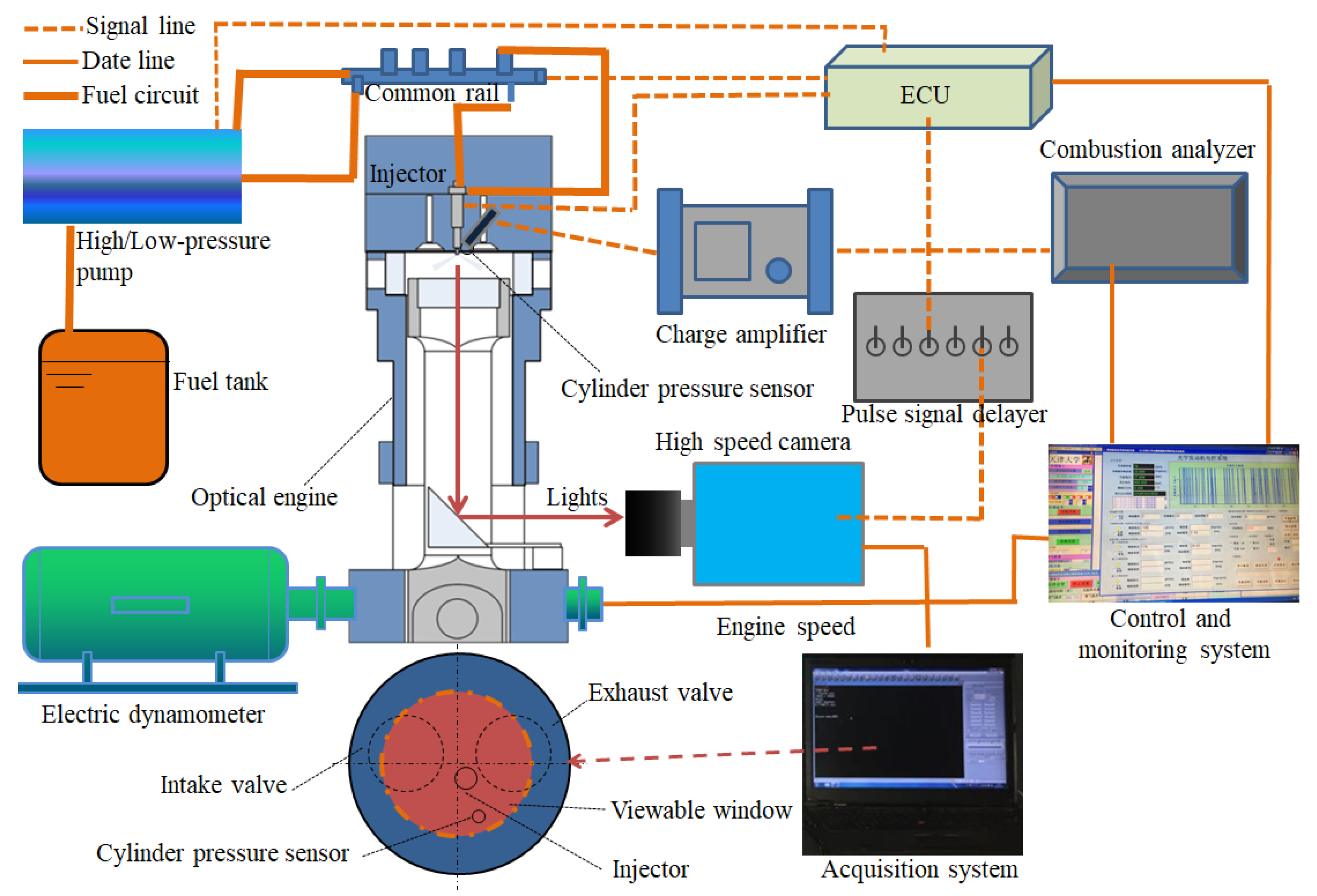
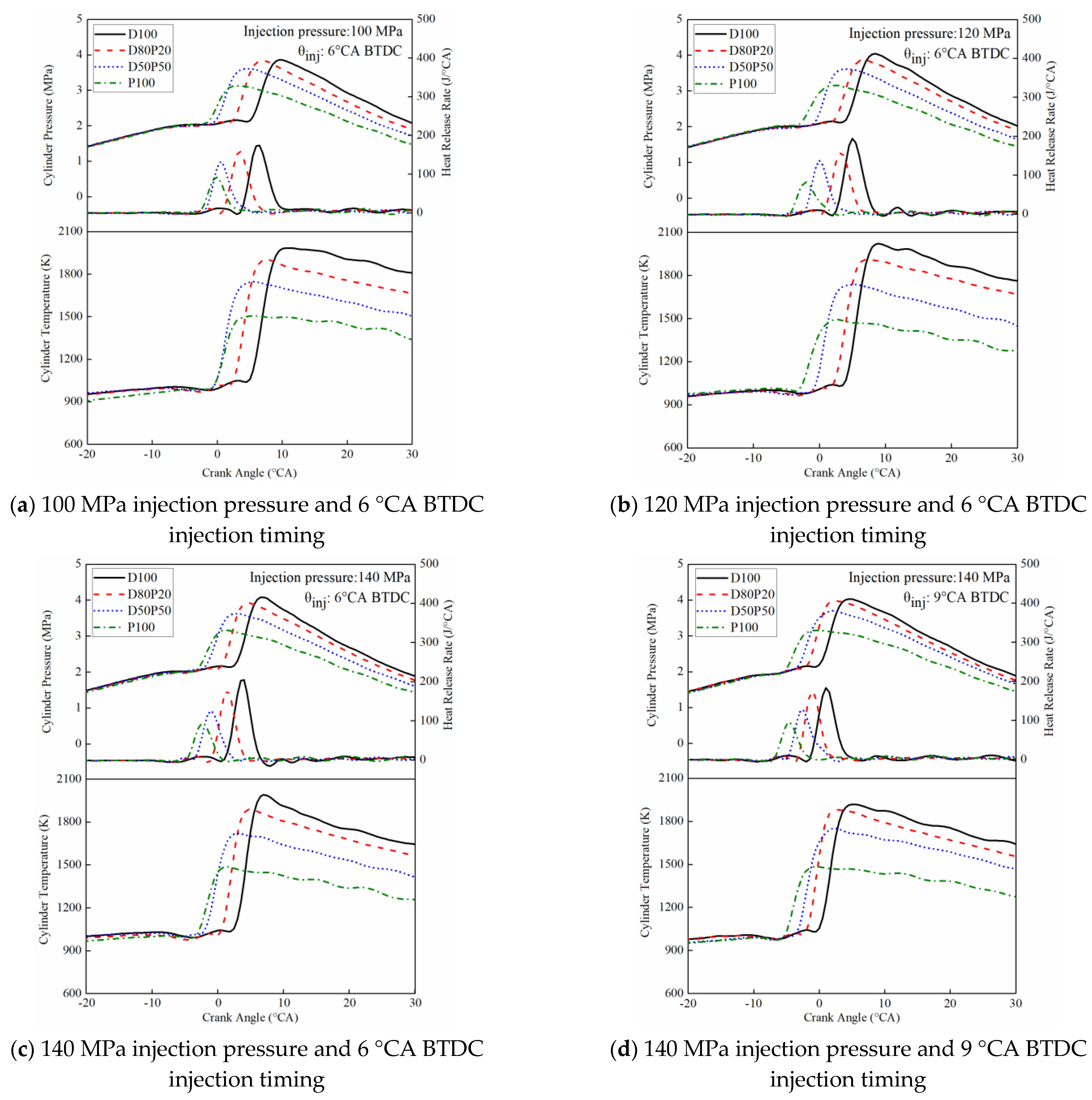
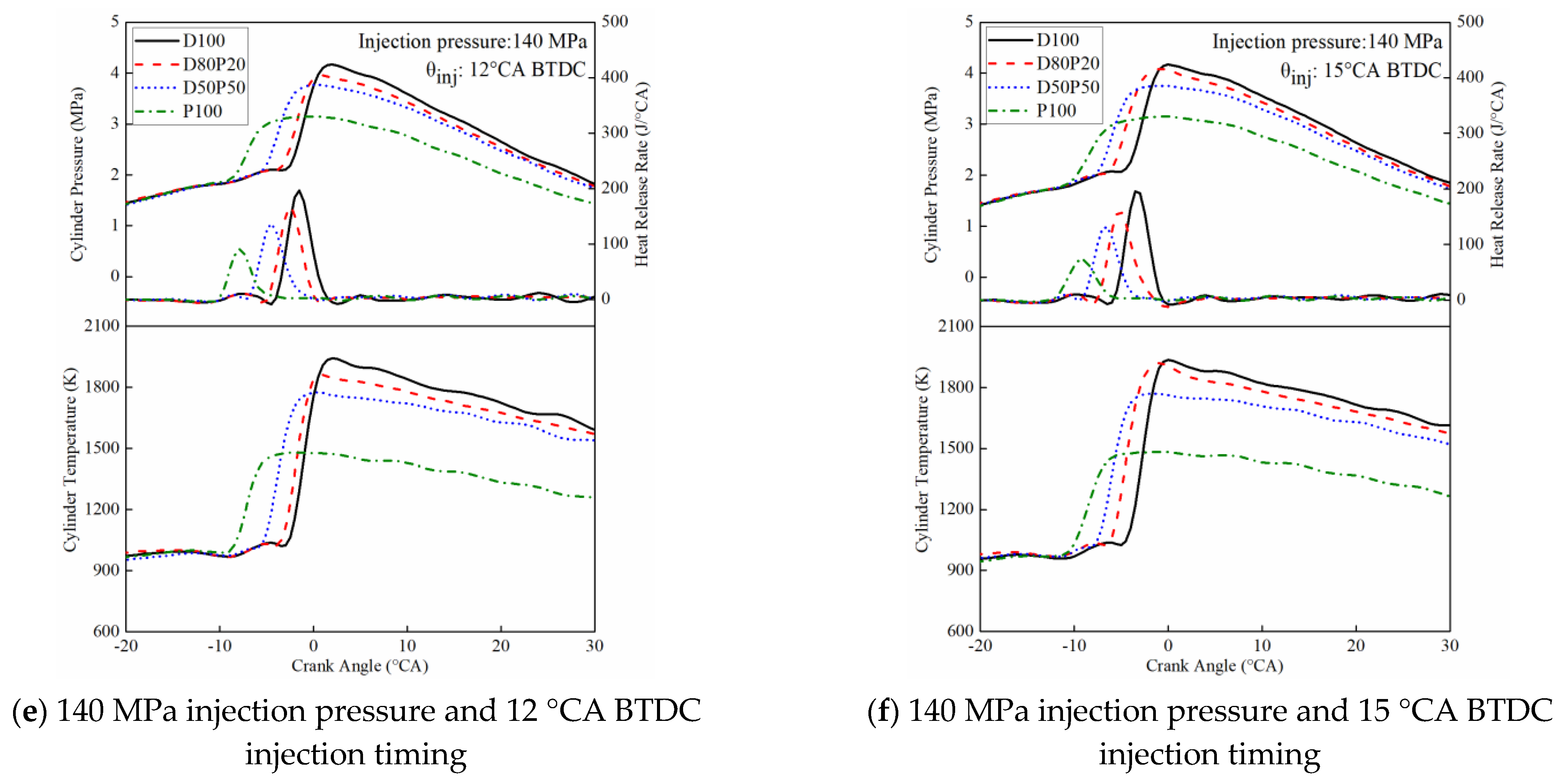

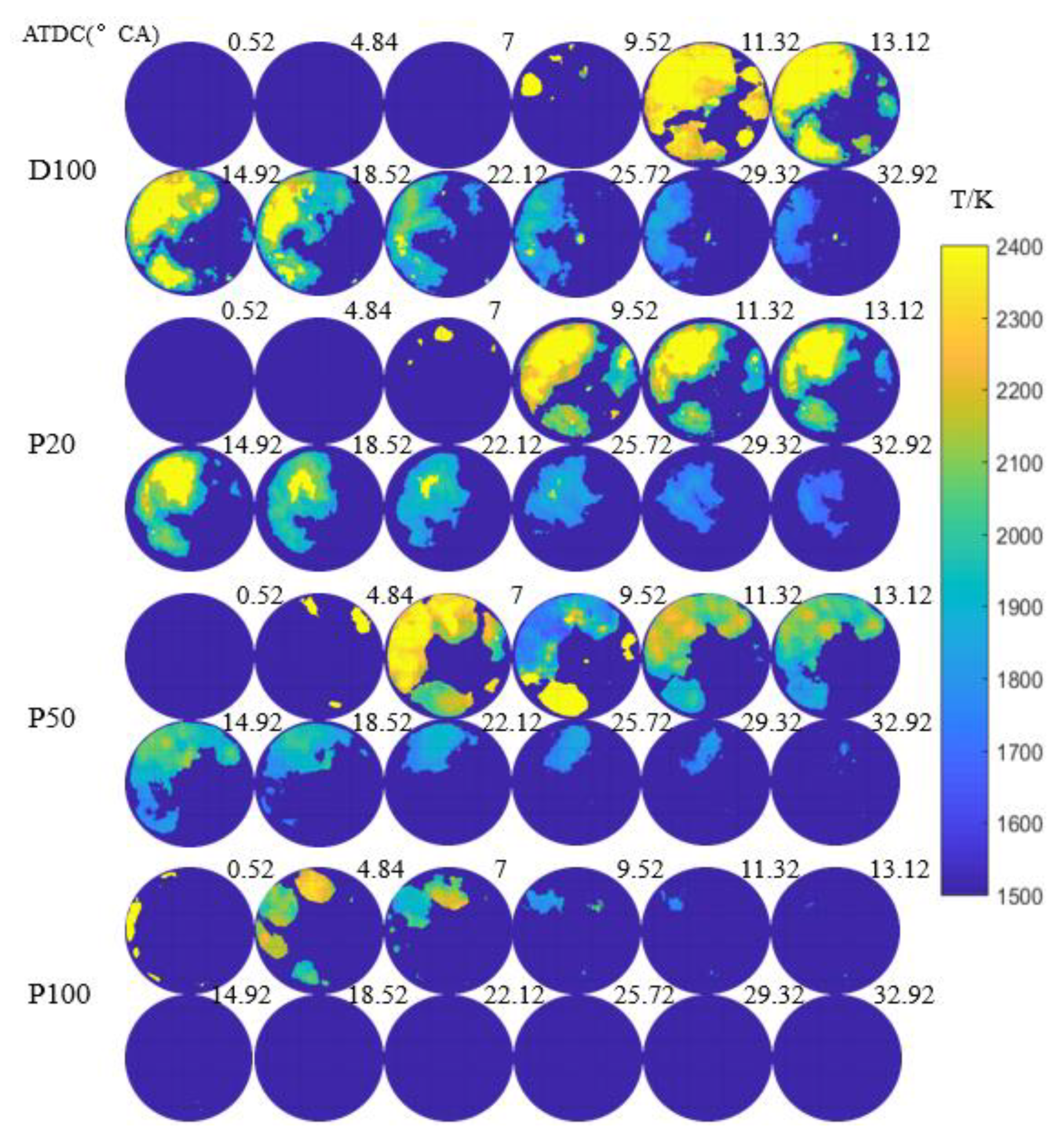
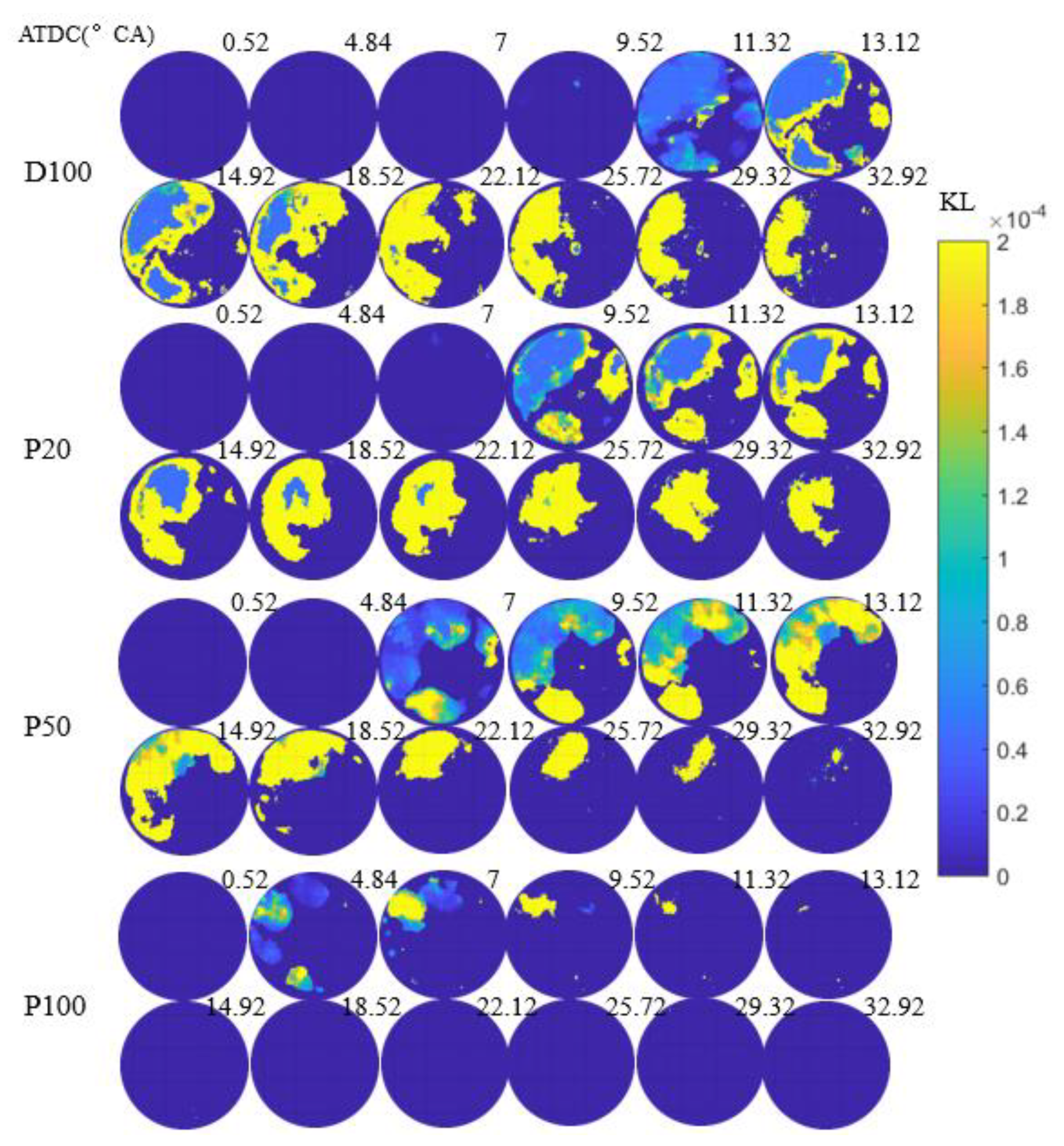
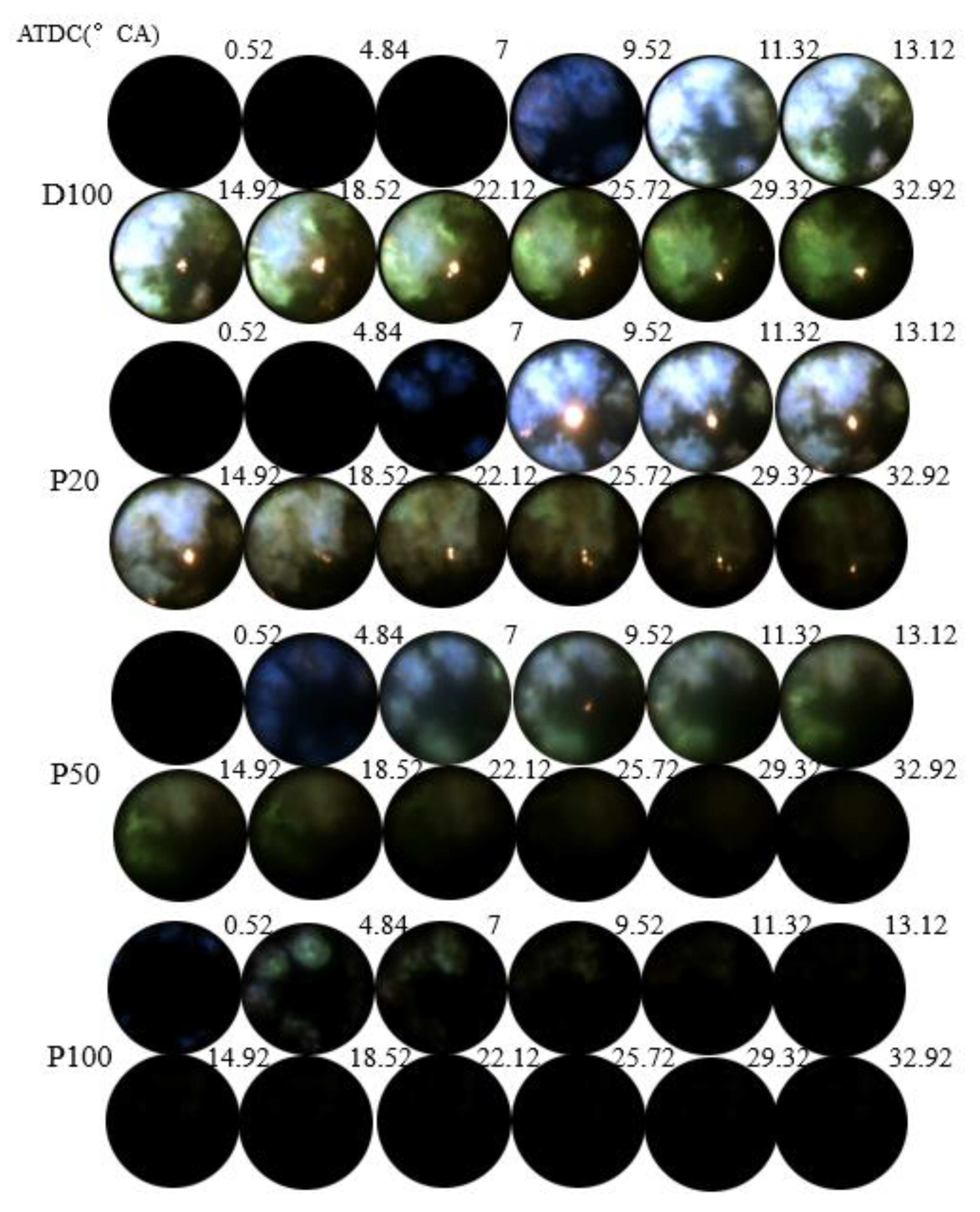

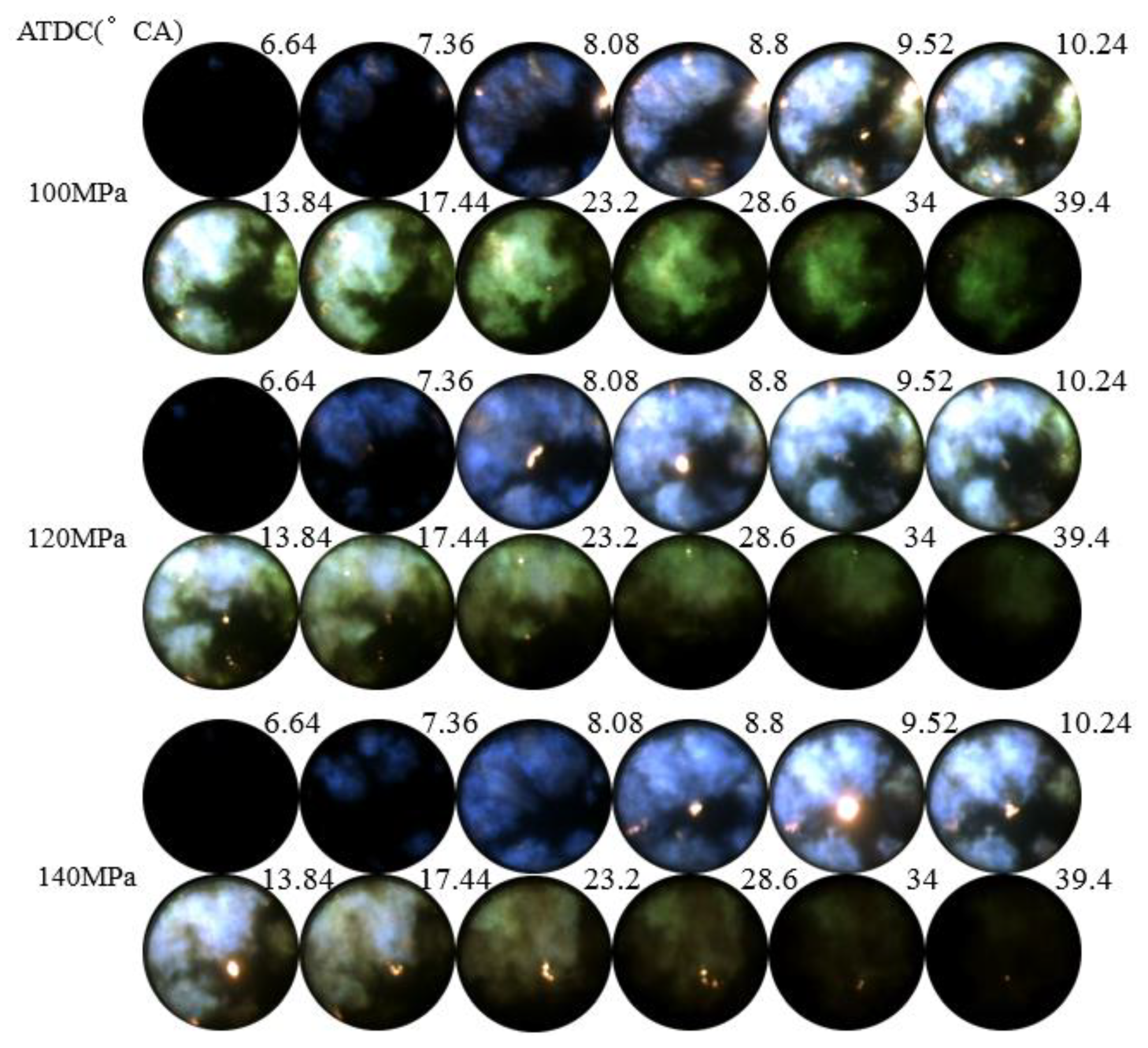
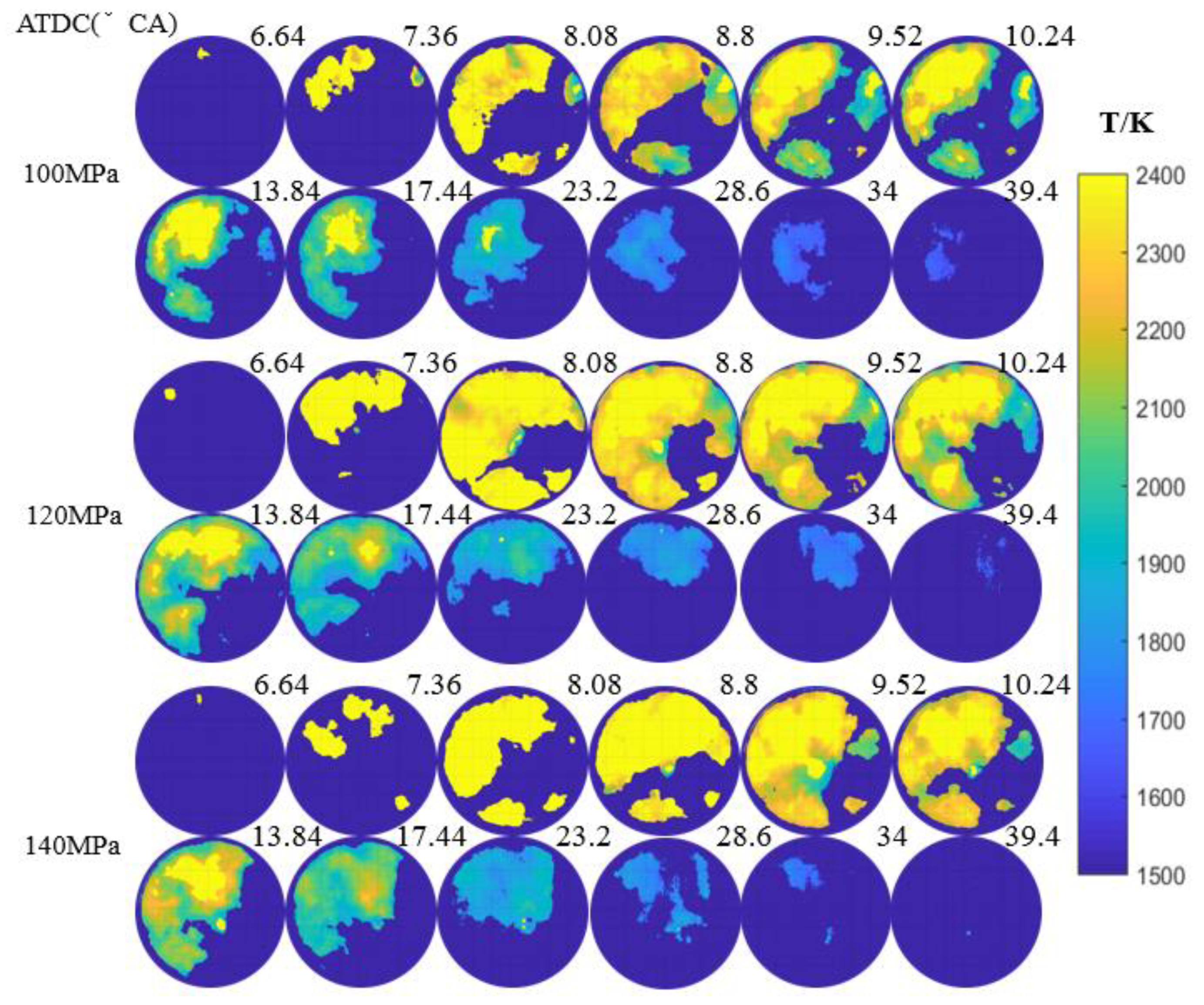
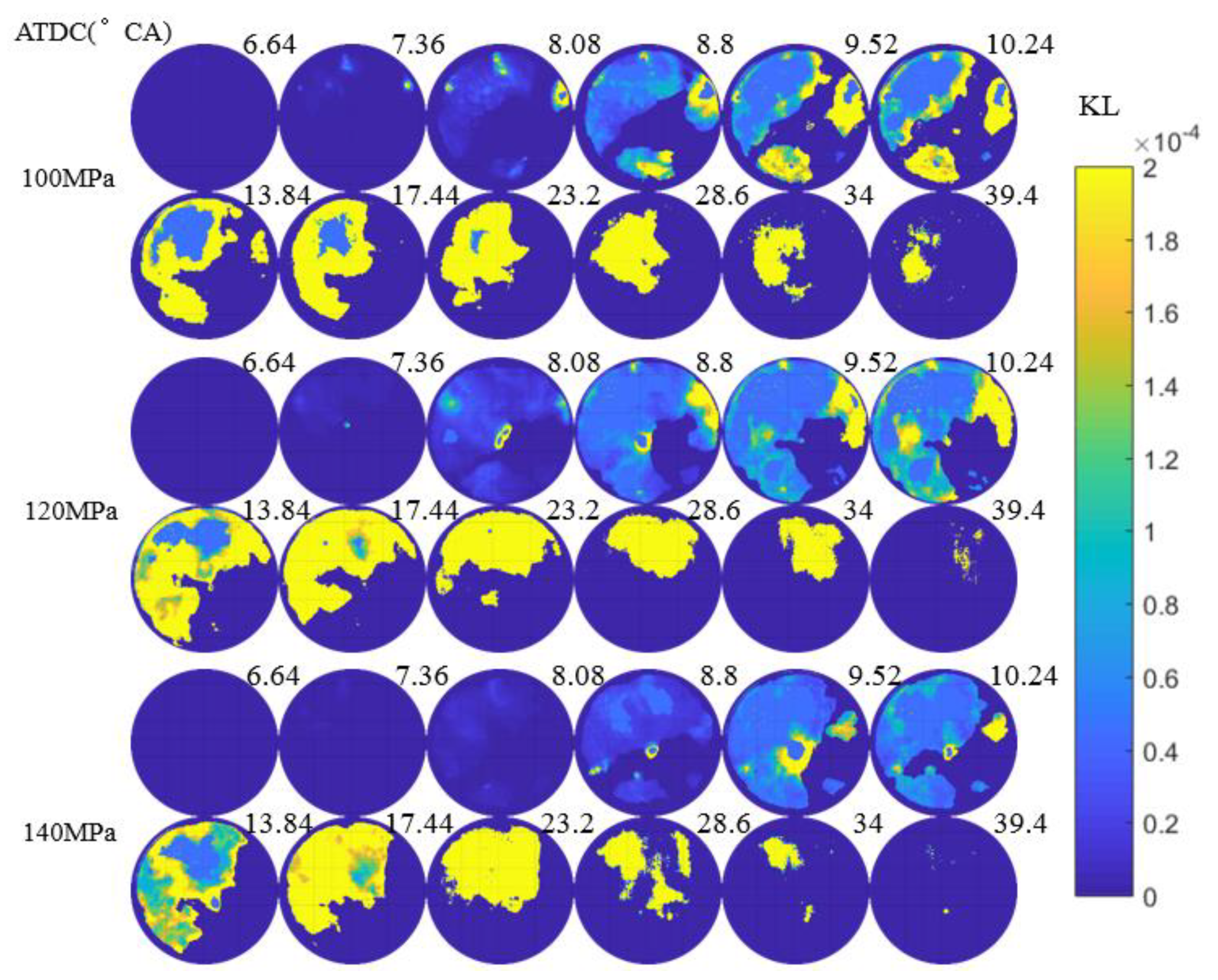
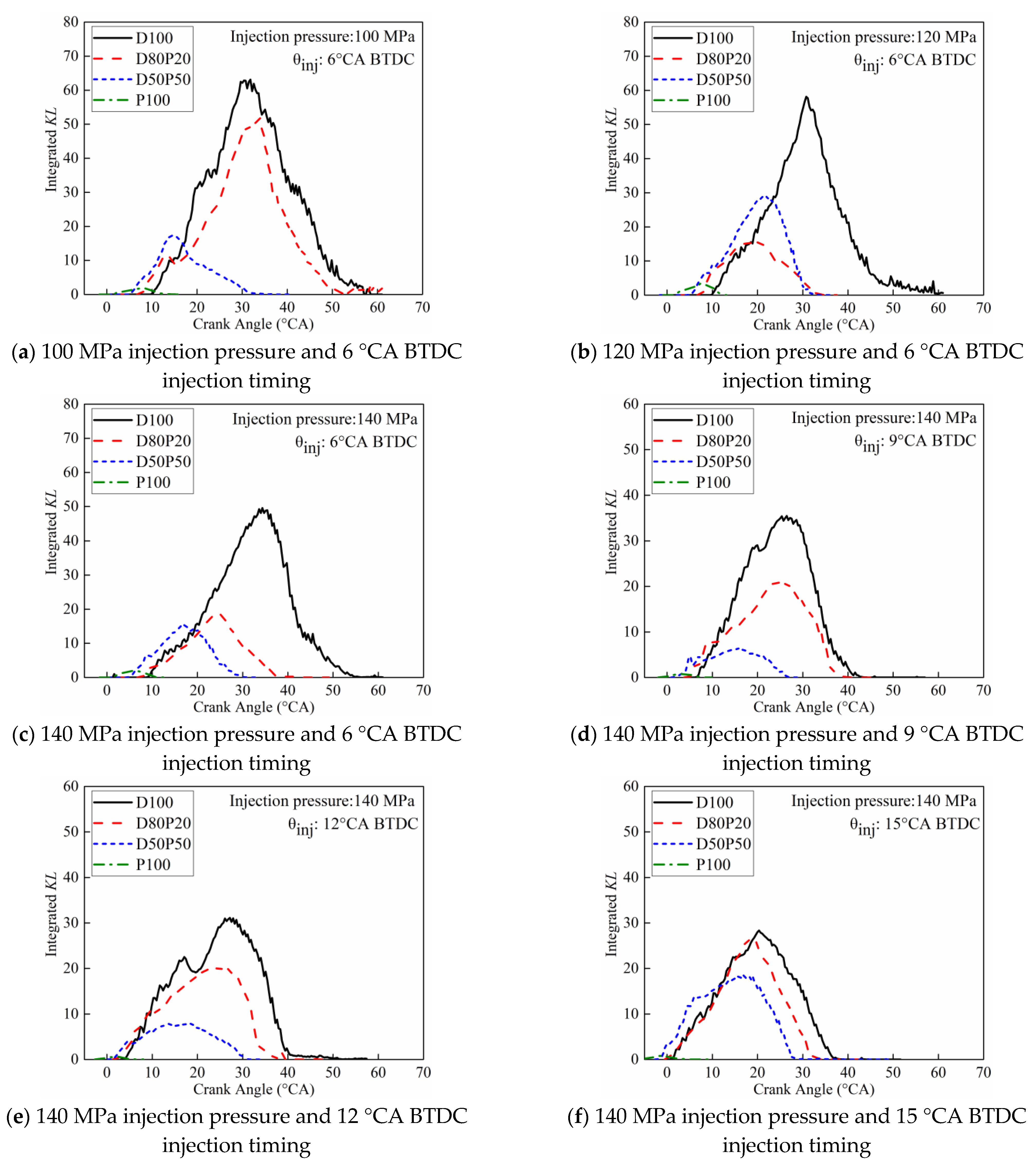
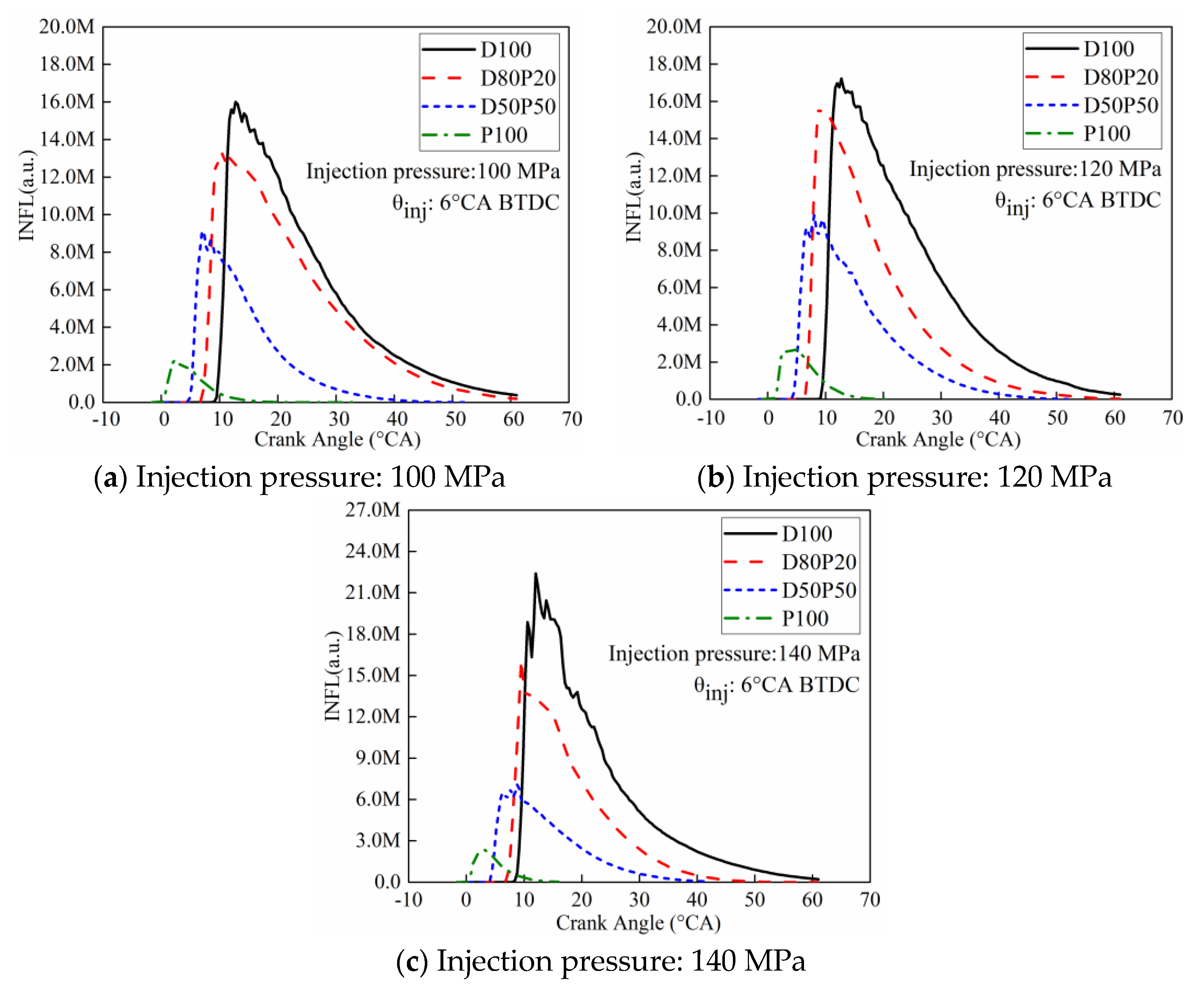
| Parameter | Value |
|---|---|
| Connecting rod length (mm) | 155 |
| Bore×Stroke (mm) | 92 × 100 |
| Displacement (L) | 0.664 |
| Swirl ratio | 1.5 |
| Valve number | 2 |
| Compression ratio | 11 |
| Properties | D100 | P20 | P50 | P100 |
|---|---|---|---|---|
| Density (g/cm3) | 0.832 | 0.908 | 0.952 | 1.072 |
| Viscosity at 20 °C (mm2/s) | 3.34 | 3.05 | 2.66 | 1.98 |
| Cetane number | 50 | 54 | 61 | 72 |
| Lower heating value (LHV) (MJ/kg) | 44.94 | 38.79 | 35.38 | 25.81 |
| Oxygen content (%) | 0 | 10.3 | 25.7 | 43.5 |
| Distillation Temperature | D100 | PODE |
|---|---|---|
| Initial boiling point (K) | 444 | 422 |
| 50% vol recovery (K) | 548 | 450 |
| 95% vol recovery (K) | 635 | 513 |
| Final boiling point (K) | 648 | 525 |
Publisher’s Note: MDPI stays neutral with regard to jurisdictional claims in published maps and institutional affiliations. |
© 2021 by the authors. Licensee MDPI, Basel, Switzerland. This article is an open access article distributed under the terms and conditions of the Creative Commons Attribution (CC BY) license (https://creativecommons.org/licenses/by/4.0/).
Share and Cite
He, J.; Chen, H.; Su, X.; Xie, B.; Li, Q. Combustion Study of Polyoxymethylene Dimethyl Ethers and Diesel Blend Fuels on an Optical Engine. Energies 2021, 14, 4608. https://doi.org/10.3390/en14154608
He J, Chen H, Su X, Xie B, Li Q. Combustion Study of Polyoxymethylene Dimethyl Ethers and Diesel Blend Fuels on an Optical Engine. Energies. 2021; 14(15):4608. https://doi.org/10.3390/en14154608
Chicago/Turabian StyleHe, Jingjing, Hao Chen, Xin Su, Bin Xie, and Quanwei Li. 2021. "Combustion Study of Polyoxymethylene Dimethyl Ethers and Diesel Blend Fuels on an Optical Engine" Energies 14, no. 15: 4608. https://doi.org/10.3390/en14154608
APA StyleHe, J., Chen, H., Su, X., Xie, B., & Li, Q. (2021). Combustion Study of Polyoxymethylene Dimethyl Ethers and Diesel Blend Fuels on an Optical Engine. Energies, 14(15), 4608. https://doi.org/10.3390/en14154608







